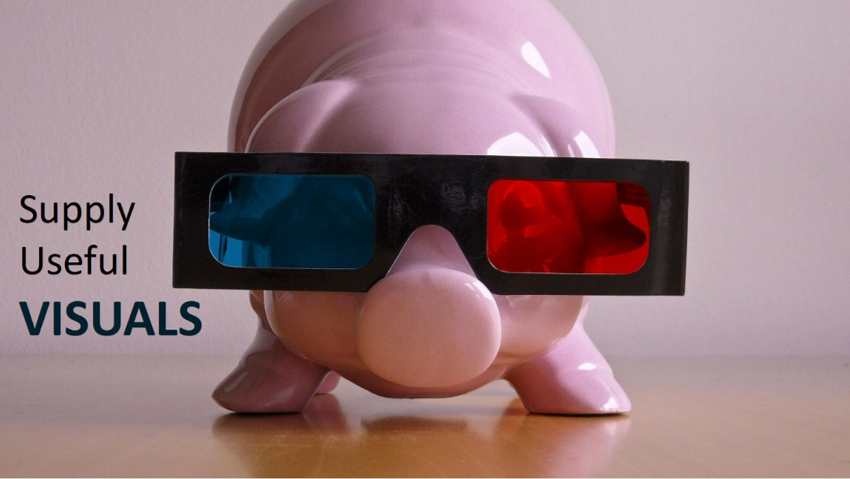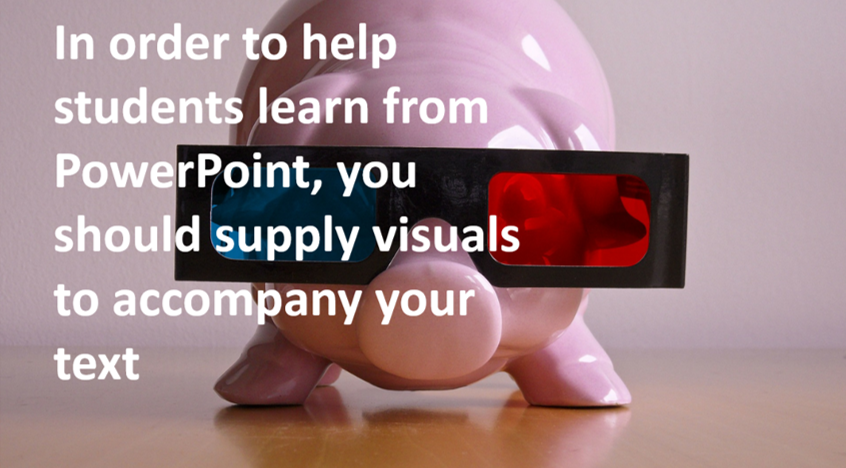Instructor-Created Videos
Instructor-created videos can be an effective and efficient way to deliver content and engage learners. When guided by best practices, instructor videos increase student satisfaction, engagement, and learning (Kay, 2012; Hsin and Cigas, 2013). Students benefit by being able to interact at their own pace and view multiple times. Instructors benefit by creating a cache of content that can be used in subsequent courses and gain flexibility by being able to move lecture content out of face-to-face class, freeing in-class time for interactive methods, which is a hallmark of flipped learning.
Videos that Teach
All learning is affected by the cognitive load required (Sweller, 1994). Because of their multi-modal nature, educational videos run the risk of cognitive overload but also provide many avenues for helpfully managing cognitive load (Mayer and Moreno 2003; Ibrahim et al., 2012).
Segment Your Videos
Segmenting means presenting information in discrete bits (exploring relationships between novel concepts is higher-level thinking and is best reserved for students who already understand key concepts). Instructors can segment information by devoting each topic to a separate video. Not only does this help students understand the material as it is presented, but when videos are well-labeled, students can easily find material they may want to review. Videos themselves can be segmented by using tools in Kaltura, for instance creating reflection points (part of the video quiz feature) that prompt students to click to move forward.
Signal and Cut
As with PowerPoint presentations, instructor videos can reduce cognitive load by visually pointing students to key information. This can be done with change in color, contrast, font, size, etc. (deKoning et al., 2009) Key information can also be signaled through retrieval practice, which can be accomplished with embedded video quizzes. Effective videos also cut or “weed out” material that does not convey or reinforce information. This prompts instructors not only to reduce unnecessary text, but also cut light, sounds, animations, etc., that do not directly relate to learning. In the first figure below, the text is very concise, and the term “visuals” is larger and in a different color. This reduces the extraneous cognitive load and points learners to the key information. Compare to the second figure below, with five times the text and no key words signaled.
Engaging Students
Students will not learn as well from videos that are a purely passive experience (Zhang et al., 2006). Intentionally engage students with the video by embedding video quizzes, providing guiding questions, or asking students to respond. Research shows that students prefer videos that are part of larger assignments rather than stand-alone information pieces (Brame, 2015). Students also appreciate when they sense the video is created specifically for their class (Guo et al., 2014), so provide context and reference class-specific readings or experiences (if you plan to reuse videos for other or future classes, these references can be conveyed in text that accompanies or introduces the video).
Technical Consideration
While instructor videos do not need to be Hollywood productions, a smooth and comfortable experience for the student helps to ensure students view and learn from your video.
Be Comfortable with Your Technology
Don’t be overly ambitious with editing or special effects, as these are not only time-consuming, but can result in extraneous cognitive load for viewers. For Baylor instructors, Kaltura is integrated in Canvas, allowing for simple webcam and screenshare videos. (See Kaltura user guide and how to record with Kaltura Capture). Instructors can also record with Zoom or WebEx (which can also share screen and have digital whiteboards) or with simple phone camera recording and upload videos into My Media on Canvas (see sidebar for additional screencasting programs).
Be Natural
Students report wanting to see their instructor’s face (as opposed to hearing voice over PowerPoint) and learn more when the instructor speaks with a quick, conversational tone (Mayer, 2008). Scripting your presentation is not necessarily deleterious, especially as it can help keep the video brief (see below), but be sure you deliver your script conversationally.
Be Seen and Heard
Make sure there are no visual or audio distractions in your video. Light yourself well (natural light or soft white light) and be sure audio is clear without background noise.
Be Brief
Research (Guo et al., 2014) shows that student viewing of instructional videos is less than 50% if they are longer than six minutes (and gets worse the longer the video). If your videos are well segmented (see above), they will also probably be brief. But for optimal viewing, you can also create a rule of thumb to record videos of no longer than six minutes.
Additional Screencasting Software
- Explain Everything (pause and re-record specific segments easily)
- Snagit (ideal for quick tutorials and explanations)
- Camtasia (ideal for heavier editing)
- Screenflow (Mac only)
- Screencast-O-Matic
- QuickTime Player (Mac only, basic version is preinstalled)
- iMovie (Mac only)
- Ezvid
References
Brame, C.J. (2015). Effective educational videos. Retrieved [4/3/2020] from http://cft.vanderbilt.edu/guides-sub-pages/effective-educational-videos/.
deKoning B., Tabbers H., Rikers R., & Paas F. (2009). Towards a framework for attention cueing in instructional animations: Guidelines for research and design. Educational Psychology Review, 21, 113-140.
Guo P.J., Kim J., & Robin R. (2014). How video production affects student engagement: An empirical study of MOOC videos. ACM Conference on Learning at Scale (L@S 2014); found at http://groups.csail.mit.edu/uid/other-pubs/las2014-pguo-engagement.pdf.
Hsin W.J. & Cigas J. (2013). Short videos improve student learning in online education. Journal of Computing Sciences in Colleges, 28, 253-259.
Ibrahim M., Antonenko P.D., Greenwood C.M., & Wheeler D. (2012). Effects of segmenting, signaling, and weeding on learning from educational video. Learning, Media and Technology, 37, 220-235.
Kay R.H. (2012). Exploring the use of video podcasts in education: A comprehensive review of the literature. Computers in Human Behavior, 28, 820-831.
Mayer R.E. (2008). Applying the science of learning: Evidence-based principles for the design of multimedia instruction. Cognition and Instruction, 19, 177-213.
Mayer R.E & Moreno R. (2003). Nine ways to reduce cognitive load in multimedia learning. Educational Psychologist, 38, 43-52.
Sweller J. (1994). Cognitive load theory, learning difficulty, and instructional design. Learning and Instruction, 4, 295-312.
Zhang D., Zhou L., Briggs R.O., & Nunamaker J.F. Jr. (2006). Instructional video in e-learning: Assessing the impact of interactive video on learning effectiveness. Information & Management, 43, 15-27.

This work is licensed under a Creative Commons Attribution-NonCommercial 4.0 International License.

